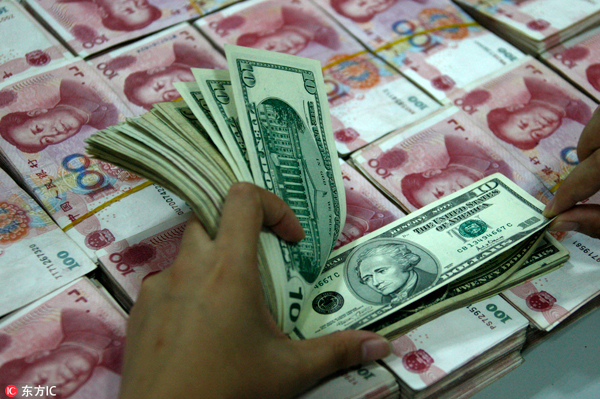
A clerk counts yuan bank notes and US dollar bills at a branch of the Industrial and Commercial Bank of China in Huaibei, East China's Anhui province. (Photo: IC)
Last week, the International Monetary Fund raised its growth forecast for the Chinese economy from 6.2 percent (which it had predicted in January) to 6.3 percent for 2019. At the same time, it downgraded its global growth forecast from 3.5 percent to 3.3 percent owing to poor world economic growth, including that of the United States.
Last year, despite obstacles such as domestic deleveraging and Sino-US trade conflicts, foreign investment in China increased, defying the global downward trend. According to Ministry of Commerce data, the actual amount of foreign capital utilized in China last year was $134.97 billion, up 3 percent year-on-year. And in China's manufacturing industry, the actual amount of foreign capital utilized increased 20.1 percent year-on-year-or 30.6 percent of the actual foreign capital utilized in the country-4.8 percentage points higher than 2017.
According to the United Nations' latest Global Investment Trend Monitor, the total foreign direct investment globally last year was close to $1.2 trillion-19 percent less than in 2017-with the US still attracting the highest amount of foreign investment ($226 billion).
But the GITM also shows that last year the actual amount of foreign investment utilized in the US declined 18.4 percent year-on-year. This means the gap between China and the US in terms of utilizing foreign investment has narrowed because of the US' trade policies leading to trade conflicts with its trading partners, especially with China.
China's GDP grew 6.6 percent last year, slower than the previous years because of, among other factors, the global economic downturn. The Government Work Report which Premier Li Keqiang presented at the National People's Congress on March 5 said China's GDP growth target for 2019 is 6-6.5 percent, slightly lower than last year. But compared with the global economic situation, China's economy is still growing steadily.
As for the Chinese government's debt ratio, it is comparatively low. The Chinese government plans to increase the fiscal deficit ratio by 0.2 percentage points to 2.8 percent of GDP. But the figure would still be lower than the 3 percent international warning line.
The Government Work Report also stresses that China will continue to implement a positive fiscal policy and a steady monetary policy.
On March 20, the State Council, China's Cabinet, decided to reduce the value-added tax for several industries including the manufacturing industry from 16 percent to 13 percent, and other sectors such as transportation and construction industries from 10 percent to 9 percent. Which suggests China is in a position to achieve its growth target this year, which in turn will make it more attractive to foreign investment.
Many investors and observers are bullish on China's economic outlook. According to the Business Climate Survey 2018 of the American Chamber of Commerce in China, about 60 percent of the enterprises interviewed said China was one of the three major investment destinations. And the European Union Chamber of Commerce in China's Business Confidence Survey 2018 said more than half of its member enterprises plan to expand operations in China.
And if the US Federal Reserve stops increasing the interest rate and the US stock market becomes increasingly volatile, some foreign capital may flow out of the US, and a part of that capital could make its way into the Chinese market.
China has implemented new policies and regulations to attract more foreign capital. The Foreign Investment Law, passed on March 15, indicates China's investment environment will further improve. Also, Li has said the Foreign Investment Law will not only better protect foreign investment but also attract more foreign capital. As global economic growth slows down and the Chinese economy maintains stable growth, it is expected that China will attract more foreign investment in the future.


